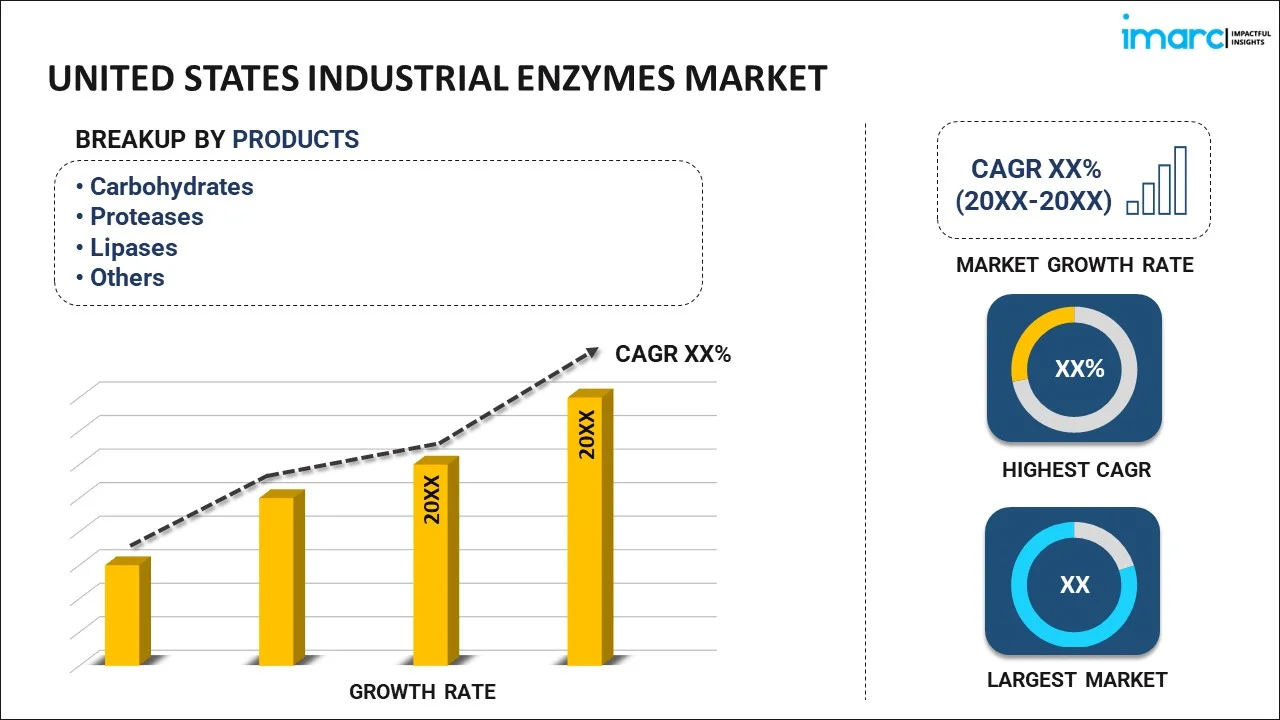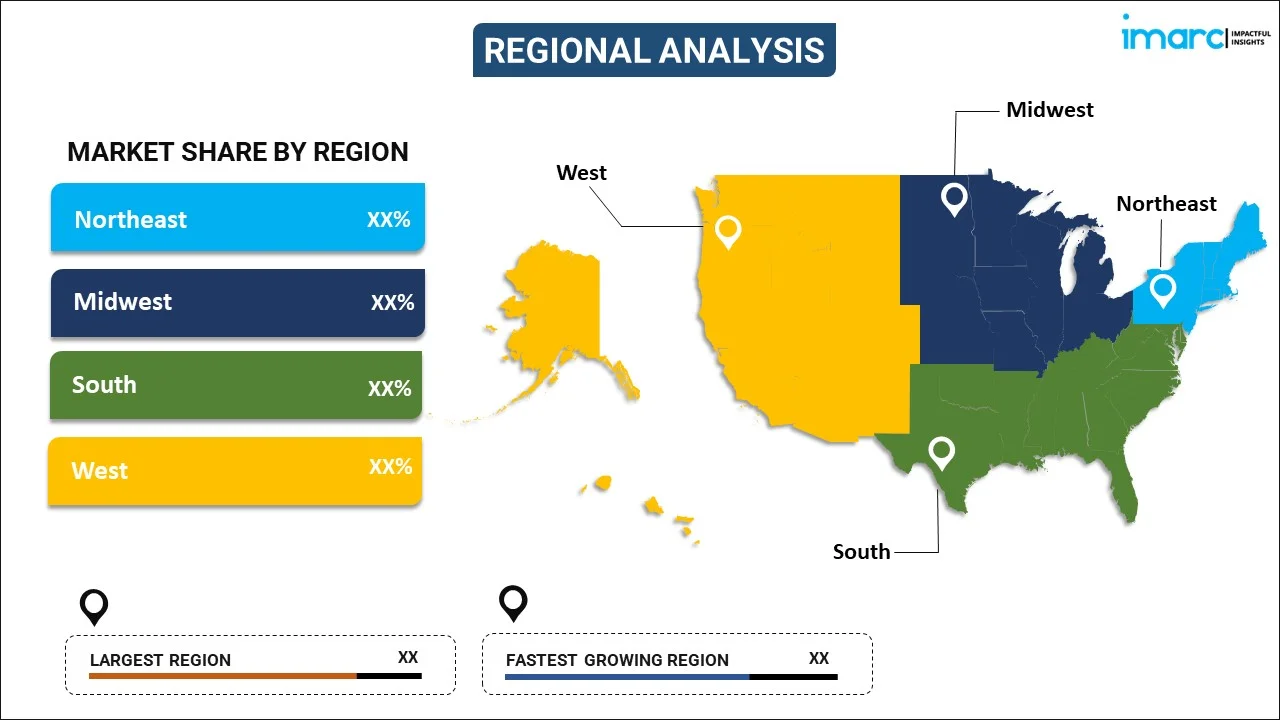
United States Industrial Enzymes Market Report by Product (Carbohydrates, Proteases, Lipases, Polymerases and Nucleases, and Others), Source (Plants, Animals, Microorganisms), Application (Food and Beverages, Detergents, Animal Feed, Biofuels, Textiles, Pulp and Paper, Nutraceuticals, Personal Care and Cosmetics, Wastewater Treatment, and Others), and Region 2025-2033
Market Overview:
United States industrial enzymes market size reached USD 1.8 Billion in 2024. Looking forward, IMARC Group expects the market to reach USD 2.4 Billion by 2033, exhibiting a growth rate (CAGR) of 3.4% during 2025-2033. The growing demand for biofuels, driven by environmental concerns, rising collaboration between key market players to discover and develop new formulations and increasing development in production techniques, such as protein engineering and metagenomics, represent some of the key factors driving the market.
|
Report Attribute
|
Key Statistics
|
|---|---|
|
Base Year
|
2024 |
|
Forecast Years
|
2025-2033
|
|
Historical Years
|
2019-2024
|
| Market Size in 2024 | USD 1.8 Billion |
| Market Forecast in 2033 | USD 2.4 Billion |
| Market Growth Rate (2025-2033) | 3.4% |
United States Industrial Enzymes Market Insights:
- Major Market Drivers: Growing need for sustainable and cost-effective production processes in various sectors like biofuels, food, textiles, and cleaning is a major driver of the United States industrial enzymes market share, backed by regulatory approval and a move towards green technologies.
- Key Market Trends: The increasing application of enzyme-based solutions in food processing in plants, in biodegradable detergents, and in textile bio-finishing points to a trend towards ecofriendly alternatives that coincide with sustainable production and clean-label manufacturing across many industrial sectors.
- Competitive Landscape: The US industrial enzymes industry is marked by innovation-driven approaches, with leading players allocating resources to research and development (R&D) enzyme optimization, and customized applications to address particular sector requirements, allowing for product differentiation and strengthening competitive positioning through sophisticated enzyme formulations.
- Challenges and Opportunities: While process standardization and regulatory oversight pose challenges, opportunities include widening the application of enzymes in pharmaceuticals, agriculture, and waste treatment, where enzyme-mediated biocatalysis provides scalable, environment-friendly alternatives to conventional chemical-based processes
United States Industrial Enzymes Market Trends:
Increasing Role of Enzymes in Biofuel and Green Energy Applications
The growing emphasis on sustainable energy resources is driving the need for industrial enzymes in the production of biofuels, particularly ethanol and biodiesel, propelling United States industrial enzymes market demand. Cellulases and amylases are important in degrading plant biomass to fermentable sugar, improving the yield of biofuels at a lowered energy input. The shift is in line with country policies focusing on emissions reduction and energy diversification. Federal incentives for the adoption of clean energy further support the use of enzyme-based technologies. Industrial enzymes also play a role in cost-efficient and environmentally-sound bioconversion processes, and thus are essential to the renewable energy industry. The United States industrial enzymes market outlook is highly based on this trend, as energy producers incorporate enzyme technologies more and more to ensure scalability and efficiency. This innovation not only advances sustainability objectives but also enhances the nation's strategic standing in the international bioeconomy, supporting the long-term sustainability of enzyme innovation across new clean energy platforms.
Growing Demand in Food Processing and Nutritional Enrichment
Industrial enzymes are now front and center in revolutionizing food and beverage manufacturing across the United States, driven by consumer interest in clean-label, healthy, and functional foods. Enzymes such as proteases, amylases, and lipases are being widely applied in uses ranging from baking and brewing to dairy processing and dietary supplements. Their ability to enhance flavor, texture, digestibility, and shelf-life positions enzymes as inevitable players in today's food innovation. Moreover, regulatory acceptance of enzyme-based processing aids increases uptake in foods. The boost in enzyme applications into animal nutrition, specifically into feed efficiency and gut health, is also playing an important role in driving the United States industrial enzymes market growth and diversification. For instance, in January 2023, Cargill and BASF extended their enzyme collaboration to the United States with the launch of high-performance enzyme solutions for improving animal feed efficiency, sustainability, and productivity for U.S. protein producers. Moreover, demand in the market will rise over time as manufacturers consolidate operations with enzyme technology to meet shifting health and quality needs. This shift also reflects general market patterns, where enzyme-assisted solutions offer cost-effective means of achieving product consistency, waste elimination, and processing yield improvement at the expense of clean-label requirements and dietary demands.
Heightened Enzyme Application in Industrial Cleaning and Textile Processing
The broadening of enzyme uses into non-traditional industries is reflected in their growing use in industrial cleaning and textile processing. Enzymes are highly used in place of aggressive chemicals in detergents, textile desizing, and leather processing because they are biodegradable and substrate specific. In industrial cleaning, proteases and lipases are used to remove organic residues without surface damage, raising performance and safety levels. In textiles, enzymes take the place of poisonous chemicals in applications like bleaching, bio-polishing, and stonewashing, generating more environmentally friendly production. These developments align with United States industrial enzymes market trends, which emphasize sustainable, efficient alternatives across diverse application areas. These complement the heightening focus on sustainable industrial processes. Based on recent market outlook, this growth into non-traditional markets indicates a considerable change in application range. The direction of the market is further established by formulating innovation technologies and cross-industry mergers, reiterating the United States industrial enzymes market size and increasing its strategic position in eco-friendly industrial changes.
United States Industrial Enzymes Market Segmentation:
IMARC Group provides an analysis of the key trends in each segment of the market, along with forecasts at the country level for 2025-2033. Our report has categorized the market based on product, source, and application.
Product Insights:

To get more information on this market, Request Sample
- Carbohydrates
- Amylases
- Cellulase
- Others
- Proteases
- Lipases
- Polymerases and Nucleases
- Others
The report has provided a detailed breakup and analysis of the market based on the product. This includes carbohydrates (amylases, cellulase, and others), proteases, lipases, polymerases and nucleases, and others.
Source Insights:
- Plants
- Animals
- Microorganisms
A detailed breakup and analysis of the market based on the source have also been provided in the report. This includes plants, animals, and microorganisms.
Application Insights:
- Food and Beverages
- Detergents
- Animal Feed
- Biofuels
- Textiles
- Pulp and Paper
- Nutraceuticals
- Personal Care and Cosmetics
- Wastewater Treatment
- Others
The report has provided a detailed breakup and analysis of the market based on the application. This includes food and beverages, detergents, animal feed, biofuels, textiles, pulp and paper, nutraceuticals, personal care and cosmetics, wastewater treatment, and others.
Regional Insights:

- Northeast
- Midwest
- South
- West
The report has also provided a comprehensive analysis of all the major regional markets, which include Northeast, Midwest, South, and West.
Competitive Landscape:
The market research report has also provided a comprehensive analysis of the competitive landscape. Competitive analysis such as market structure, key player positioning, top winning strategies, competitive dashboard, and company evaluation quadrant has been covered in the report. Also, detailed profiles of all major companies have been provided.
Latest News and Developments:
- In June 2025, Novonesis completed the acquisition of dsm-firmenich's interest in Feed Enzyme Alliance upon receipt of all necessary regulatory clearances. The deal enhances Novonesis' leadership in the animal biosolutions business, supporting its growth vision and increasing its position in the United States industrial enzymes business centered on enzyme-based feed solutions.
- In February 2025, enzyme laundry detergents appeared as a green innovation among U.S. home care products. Leverage advanced biocatalysts like proteases and mannanases, these products provide efficient stain elimination at low temperatures, saving energy, maintaining fabric quality, and being part of eco-friendly household cleaning habits.
United States Industrial Enzymes Market Report Coverage:
| Report Features | Details |
|---|---|
| Base Year of the Analysis | 2024 |
| Historical Period | 2019-2024 |
| Forecast Period | 2025-2033 |
| Units | Billion USD |
| Scope of the Report | Exploration of Historical and Forecast Trends, Industry Catalysts and Challenges, Segment-Wise Historical and Predictive Market Assessment:
|
| Products Covered |
|
| Sources Covered | Plants, Animals, Microorganisms |
| Applications Covered | Food and Beverages, Detergents, Animal Feed, Biofuels, Textiles, Pulp and Paper, Nutraceuticals, Personal Care and Cosmetics, Wastewater Treatment, Others |
| Regions Covered | Northeast, Midwest, South, West |
| Customization Scope | 10% Free Customization |
| Post-Sale Analyst Support | 10-12 Weeks |
| Delivery Format | PDF and Excel through Email (We can also provide the editable version of the report in PPT/Word format on special request) |
Key Benefits for Stakeholders:
- IMARC’s industry report offers a comprehensive quantitative analysis of various market segments, historical and current market trends, market forecasts, and dynamics of the United States industrial enzymes market from 2019-2033.
- The research report provides the latest information on the market drivers, challenges, and opportunities in the United States industrial enzymes market.
- Porter's five forces analysis assist stakeholders in assessing the impact of new entrants, competitive rivalry, supplier power, buyer power, and the threat of substitution. It helps stakeholders to analyze the level of competition within the United States industrial enzymes industry and its attractiveness.
- Competitive landscape allows stakeholders to understand their competitive environment and provides an insight into the current positions of key players in the market.
Key Questions Answered in This Report
The industrial enzymes market in the United States was valued at USD 1.8 Billion in 2024.
The United States industrial enzymes market is projected to exhibit a CAGR of 3.4% during 2025-2033, reaching a value of USD 2.4 Billion by 2033.
The market is spurred by mounting demand for environmentally friendly and sustainable production methods in industries like biofuels, food, textile, and cleaning. Support from government policies favoring green technologies, enzyme engineering advancements, and the requirement to increase efficiency of production and minimize waste further drive adoption. Enzymes also provide cost reduction and improved product quality in industrial processes.
Need more help?
- Speak to our experienced analysts for insights on the current market scenarios.
- Include additional segments and countries to customize the report as per your requirement.
- Gain an unparalleled competitive advantage in your domain by understanding how to utilize the report and positively impacting your operations and revenue.
- For further assistance, please connect with our analysts.
 Request Customization
Request Customization
 Speak to an Analyst
Speak to an Analyst
 Request Brochure
Request Brochure
 Inquire Before Buying
Inquire Before Buying




.webp)




.webp)












